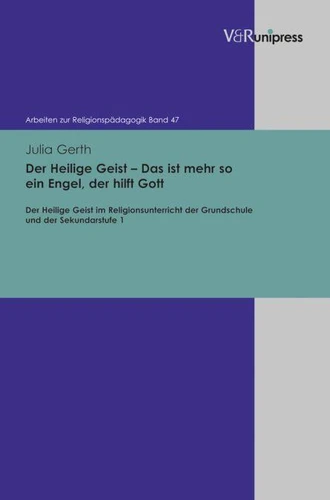Der Heilige Geist – Das ist mehr so ein Engel, der hilft Gott. Der Heilige Geist im Religionsunterricht der Grundschule und der Sekundarstufe 1
Par : , , ,Formats :
Disponible dans votre compte client Decitre ou Furet du Nord dès validation de votre commande. Le format PDF est :
- Compatible avec une lecture sur My Vivlio (smartphone, tablette, ordinateur)
- Compatible avec une lecture sur liseuses Vivlio
- Pour les liseuses autres que Vivlio, vous devez utiliser le logiciel Adobe Digital Edition. Non compatible avec la lecture sur les liseuses Kindle, Remarkable et Sony
 , qui est-ce ?
, qui est-ce ?Notre partenaire de plateforme de lecture numérique où vous retrouverez l'ensemble de vos ebooks gratuitement
Pour en savoir plus sur nos ebooks, consultez notre aide en ligne ici
- Nombre de pages466
- FormatPDF
- ISBN978-3-86234-824-4
- EAN9783862348244
- Date de parution16/06/2011
- Protection num.pas de protection
- Taille3 Mo
- Infos supplémentairespdf
- ÉditeurV&R Unipress
Résumé
The Holy Ghost has hitherto seldom been a topic in religious communication. This is clearly revealed by a detailed analysis of school textbooks and the legal requirements for religious education carried out in Lower Saxony. Also in research relating to child theology, the Holy Ghost has until now hardly been considered. In 33 interviews, therefore, 4th and 8th grade pupils are questioned with regard to their pneumatological concepts, and their own personal spiritual beliefs elicited and examined against the background of academic pneumatology.
It becomes clear how differently theologians, school textbooks and pupils treat the subject and how urgent the need is for something to be done from the perspective of religious education if pneumatological content is not to disappear completely from the religious curriculum. The book concludes with new didactic ideas drawn up in the light of the empirical survey for the "Holy Ghost" topic in religious education.
It becomes clear how differently theologians, school textbooks and pupils treat the subject and how urgent the need is for something to be done from the perspective of religious education if pneumatological content is not to disappear completely from the religious curriculum. The book concludes with new didactic ideas drawn up in the light of the empirical survey for the "Holy Ghost" topic in religious education.
The Holy Ghost has hitherto seldom been a topic in religious communication. This is clearly revealed by a detailed analysis of school textbooks and the legal requirements for religious education carried out in Lower Saxony. Also in research relating to child theology, the Holy Ghost has until now hardly been considered. In 33 interviews, therefore, 4th and 8th grade pupils are questioned with regard to their pneumatological concepts, and their own personal spiritual beliefs elicited and examined against the background of academic pneumatology.
It becomes clear how differently theologians, school textbooks and pupils treat the subject and how urgent the need is for something to be done from the perspective of religious education if pneumatological content is not to disappear completely from the religious curriculum. The book concludes with new didactic ideas drawn up in the light of the empirical survey for the "Holy Ghost" topic in religious education.
It becomes clear how differently theologians, school textbooks and pupils treat the subject and how urgent the need is for something to be done from the perspective of religious education if pneumatological content is not to disappear completely from the religious curriculum. The book concludes with new didactic ideas drawn up in the light of the empirical survey for the "Holy Ghost" topic in religious education.



